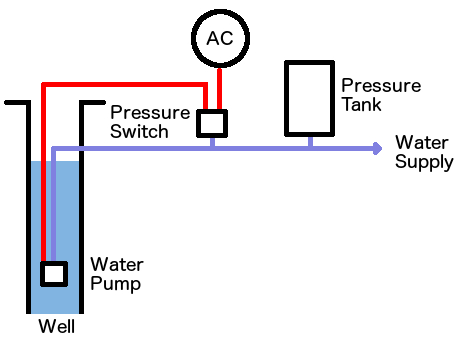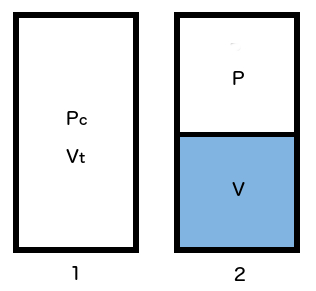Pressurizer on:
[Wikipedia]
[Google]
[Amazon]
 A pressure tank or pressurizer is used in a piping system to maintain a desired
A pressure tank or pressurizer is used in a piping system to maintain a desired
 Referring to the figure on the left, a submersible water pump is installed in a
Referring to the figure on the left, a submersible water pump is installed in a  Referring to the diagram on the right, a pressure tank is generally pressurized when empty with a "charging pressure" ''Pc'', which is usually about 2 psi below the turn-on pressure ''Plo'' (Case 1). The total volume of the tank is ''Vt''. When in use, the air in the tank will be compressed to pressure ''P'' and there will be a volume ''V'' of water in the tank (Case 2). In the following development, all pressures are gauge pressures, which are the pressures above
Referring to the diagram on the right, a pressure tank is generally pressurized when empty with a "charging pressure" ''Pc'', which is usually about 2 psi below the turn-on pressure ''Plo'' (Case 1). The total volume of the tank is ''Vt''. When in use, the air in the tank will be compressed to pressure ''P'' and there will be a volume ''V'' of water in the tank (Case 2). In the following development, all pressures are gauge pressures, which are the pressures above
 A pressure tank or pressurizer is used in a piping system to maintain a desired
A pressure tank or pressurizer is used in a piping system to maintain a desired pressure
Pressure (symbol: ''p'' or ''P'') is the force applied perpendicular to the surface of an object per unit area over which that force is distributed. Gauge pressure (also spelled ''gage'' pressure)The preferred spelling varies by country and e ...
. Applications include buffering water pressure in homes.
A simple well water control system
 Referring to the figure on the left, a submersible water pump is installed in a
Referring to the figure on the left, a submersible water pump is installed in a well
A well is an excavation or structure created in the ground by digging, driving, or drilling to access liquid resources, usually water. The oldest and most common kind of well is a water well, to access groundwater in underground aquifers. The ...
. The pressure switch
A pressure switch is a form of switch that operates an electrical contact when a certain set fluid pressure has been reached on its input. The switch may be designed to make contact either on pressure rise or on pressure fall. Pressure switches ar ...
turns the water pump on when it senses a pressure that is less than ''Plo'' and turns it off when it senses a pressure greater than ''Phi''. While the pump is on, the pressure tank fills up. The pressure tank is then depleted as it supplies water in the specified pressure range to prevent "short-cycling", in which the pump tries to establish the proper pressure by rapidly cycling between ''Plo'' and ''Phi''.
A simple pressure tank would be just a tank which held water with an air space above the water which would compress as more water entered the tank. Modern systems isolate the water from the pressurized air using a flexible rubber or plastic diaphragm or bladder, because otherwise the air will dissolve in the water and be removed from the tank by usage. Eventually there will be little or no air and the tank will become "waterlogged" causing short-cycling, and will need to be drained to restore operation. The diaphragm or bladder may itself exert a pressure on the water, but it is usually small and will be neglected in the following discussion.
 Referring to the diagram on the right, a pressure tank is generally pressurized when empty with a "charging pressure" ''Pc'', which is usually about 2 psi below the turn-on pressure ''Plo'' (Case 1). The total volume of the tank is ''Vt''. When in use, the air in the tank will be compressed to pressure ''P'' and there will be a volume ''V'' of water in the tank (Case 2). In the following development, all pressures are gauge pressures, which are the pressures above
Referring to the diagram on the right, a pressure tank is generally pressurized when empty with a "charging pressure" ''Pc'', which is usually about 2 psi below the turn-on pressure ''Plo'' (Case 1). The total volume of the tank is ''Vt''. When in use, the air in the tank will be compressed to pressure ''P'' and there will be a volume ''V'' of water in the tank (Case 2). In the following development, all pressures are gauge pressures, which are the pressures above atmospheric pressure
Atmospheric pressure, also known as barometric pressure (after the barometer), is the pressure within the atmosphere of Earth. The standard atmosphere (symbol: atm) is a unit of pressure defined as , which is equivalent to 1013.25 millibars, 7 ...
(''Pa'', which is altitude dependent). The ideal gas law
The ideal gas law, also called the general gas equation, is the equation of state of a hypothetical ideal gas. It is a good approximation of the behavior of many gases under many conditions, although it has several limitations. It was first stat ...
may be written for both cases, and the amount of air in each case is equal:
:
:
where ''N'' is the number of molecules of gas (equal in both cases), ''k'' is Boltzmann's Constant
The Boltzmann constant ( or ) is the proportionality factor that relates the average relative kinetic energy of particles in a gas with the thermodynamic temperature of the gas. It occurs in the definitions of the kelvin and the gas constant, ...
and ''T'' is the temperature
Temperature is a physical quantity that expresses quantitatively the perceptions of hotness and coldness. Temperature is measured with a thermometer.
Thermometers are calibrated in various temperature scales that historically have relied o ...
in Kelvin. Assuming that the temperature is equal for both cases, the above equations can be solved for the water pressure/volume relationship in the tank:
:
:
Tanks are generally specified by their total volume ''Vt'' and the "drawdown" (''ΔV ''), which is the amount of water the tank will eject as the tank pressure goes from ''Phi'' to ''Plo'', which are established by the pressure switch:Drawdown is more simply expressed in absolute pressures:
:
:
The reason for the charging pressure can now be seen: The larger the charging pressure, the larger the drawdown. However, a charging pressure above ''Plo'' will not allow the pump to turn on when the water pressure is below ''Plo'', so it is kept a bit below ''Plo''. Another important parameter is the drawdown factor (''fΔV''), which is the ratio of the drawdown to the total tank volume:
:
This factor is independent of the tank size so that the drawdown can be calculated for any tank, given its total volume, atmospheric pressure, charging pressure, and the limiting pressures established by the pressure switch.
See also
*Pressurizer (nuclear power)
A pressurizer is a component of a pressurized water reactor. The basic design of the pressurized water reactor includes a requirement that the coolant (water) in the reactor coolant system must not boil. Put another way, the coolant must remain ...
References
Bibliography
*External links
* {{cite web, last=Direct, first=Tanks, title=Submersible Water Pumps - Sump Pumps, website=Tanks Direct, url=https://www.tanks-direct.co.uk/water-tanks/pumps/submersible-pumps/c1040?msclkid=e5cebfdffa811c204e30dce95224ebae&utm_source=bing&utm_medium=cpc&utm_campaign=Search-Water-Pumps&utm_term=water%20pumps&utm_content=Search-Water-Pumps-Submersible%20Water%20Pumps, access-date=2022-09-30 Plumbing Pressure vessels